Are you tired of seeing your beloved garden plants ravaged by pesky bugs and diseases? Worry not, for there’s a natural solution to reclaim your thriving oasis. In this article, we’ll explore a range of eco-friendly strategies to conquer garden pests and maintain a healthy, vibrant garden without relying on harsh chemicals.
Imagine a garden where beneficial insects like ladybugs and praying mantises work in harmony with your plants, naturally keeping garden pests at bay. Envision a world where essential oils and companion planting serve as your first line of defense against plant diseases and pest infestations. This is the reality we’re about to unveil, where organic pest management takes center stage, and your garden thrives in a balanced, sustainable ecosystem.
So, are you ready to learn the secrets to conquer garden pests and cultivate a lush, vibrant garden using eco-friendly methods? Let’s dive in and discover the path to a naturally pest-free paradise.
Understanding Garden Pests
Gardening can be a rewarding and fulfilling hobby, but it’s not without its challenges. One of the most common issues that gardeners face is the presence of garden pests. These unwelcome visitors can range from insects and fungi to larger animals, and they can wreak havoc on your carefully cultivated plants. Understanding the different types of garden pests and how to identify them is the first step in effectively managing them.
Pest Identification
The key to successful pest identification is to closely observe the affected plants and look for signs of damage or the presence of the pests themselves. Some common garden pests include aphids, caterpillars, spider mites, and slugs. By learning to recognize the distinctive features and behaviors of these pests, you can take appropriate action to address the problem.
Common Plant Diseases
In addition to insect pests, plant diseases can also pose a significant threat to your garden. These can be caused by a variety of pathogens, including fungi, bacteria, and viruses. Some common plant diseases include powdery mildew, leaf spot, and tomato blight. Identifying the specific disease affecting your plants is crucial for implementing the right treatment.
| Garden Pests | Identifying Characteristics | Potential Damage |
|---|---|---|
| Aphids | Small, soft-bodied insects that cluster on stems and leaves | Stunted growth, yellowing leaves, and the spread of plant diseases |
| Caterpillars | Larval stage of various moth and butterfly species, with distinct coloring and patterns | Leaf and stem damage, fruit and vegetable consumption |
| Spider Mites | Tiny, web-spinning arachnids that feed on plant sap | Discolored, wilting leaves and stunted plant growth |
| Slugs | Soft-bodied, slimy creatures that leave behind a tell-tale trail of mucus | Foliage and vegetable consumption, especially of young seedlings |
By understanding the various garden pests and common plant diseases, gardeners can take proactive steps to protect their plants and maintain a thriving, healthy garden. Stay vigilant, observe your plants closely, and be prepared to address any pest or disease issues that arise.
Preventing Pest Infestations
Protecting your garden from pests is a crucial aspect of maintaining a healthy and thriving ecosystem. By implementing proactive measures, you can effectively prevent pest infestations and safeguard your plants. The key to successful Pest Prevention lies in understanding the delicate balance of your garden’s environment and adopting an Integrated Pest Management (IPM) approach.
One of the foundational steps in preventing pest problems is to create a diverse and balanced garden. By planting a variety of native plants, you can attract a wide range of beneficial insects, such as ladybugs, lacewings, and parasitic wasps, which prey on common garden pests. This diversity helps to establish a natural predator-prey balance, discouraging pest populations from becoming overwhelming.
Maintaining healthy soil is another crucial element in Pest Prevention. Nutrient-rich, well-draining soil not only supports the overall health of your plants but also provides a thriving environment for beneficial soil organisms. These organisms play a vital role in breaking down organic matter, improving soil structure, and creating a balanced ecosystem that is less susceptible to pest infestations.
Implementing Integrated Pest Management (IPM)
Integrated Pest Management (IPM) is a holistic approach to controlling pests that focuses on long-term prevention and minimizing the use of chemical pesticides. By employing a combination of cultural, mechanical, and biological control methods, you can effectively manage pest populations without compromising the health of your garden or the surrounding environment.
- Monitor your garden regularly to detect pest problems early on.
- Use physical barriers, such as row covers or netting, to prevent pests from accessing your plants.
- Encourage the presence of beneficial insects by providing them with food sources and shelter.
- Utilize natural pest control methods, such as manual removal or the application of organic insecticides, as a last resort.
By implementing these Pest Prevention strategies and embracing an Integrated Pest Management approach, you can create a thriving, resilient garden that is less susceptible to damaging pest infestations. This not only benefits the health of your plants but also supports a balanced and sustainable ecosystem in your outdoor space.
Beneficial Insects: Nature’s Pest Control
In the pursuit of maintaining a thriving garden, it’s crucial to recognize the invaluable role played by beneficial insects. These natural allies are the unsung heroes in the battle against common garden pests, offering a sustainable and eco-friendly solution to pest control.
Attracting Beneficial Insects
To harness the power of beneficial insects, gardeners can take a few simple steps to attract and encourage their presence. By creating a hospitable environment, we can cultivate a harmonious ecosystem in our gardens, where these beneficial creatures thrive and help keep pests at bay.
- Planting a diverse array of nectar-rich flowers and herbs to provide a steady food source for beneficial insects like ladybugs, lacewings, and predatory mites.
- Incorporating water sources, such as a birdbath or shallow dish, to cater to the hydration needs of these beneficial insects.
- Avoiding the use of broad-spectrum pesticides, which can inadvertently harm the very insects we want to attract and support.
- Providing shelters and overwintering sites, such as log piles or undisturbed areas, to give beneficial insects a safe haven.
By taking these simple steps, gardeners can create an inviting environment that encourages the natural presence of beneficial insects, effectively harnessing the power of nature’s pest control.
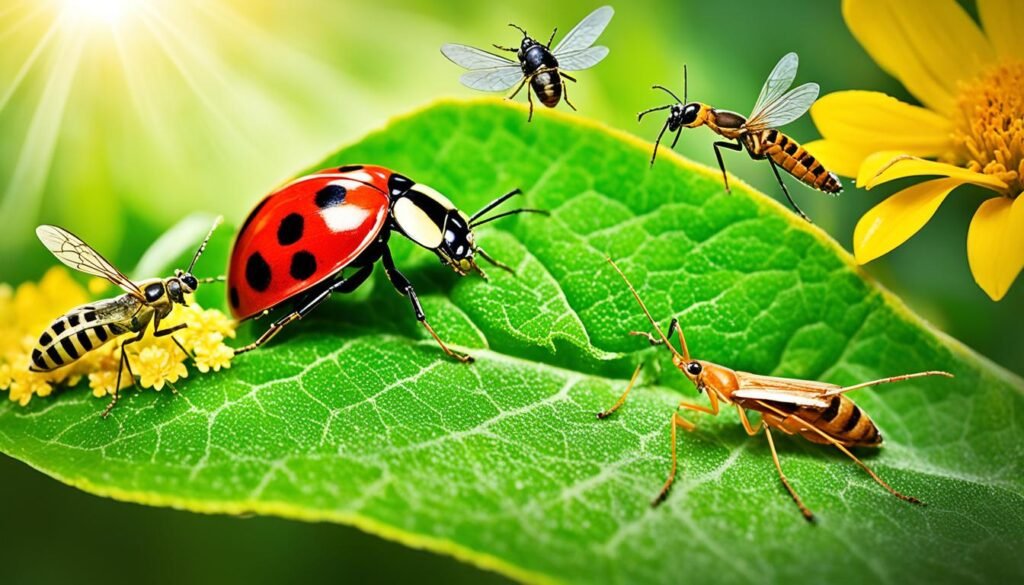
Nurturing a thriving population of beneficial insects is a key strategy in maintaining a healthy, pest-free garden. By understanding their importance and taking steps to attract them, gardeners can enjoy the benefits of a balanced, eco-friendly ecosystem that keeps pests in check, without the need for harsh chemical interventions.
Organic Pest Management Strategies
In the quest to maintain a flourishing garden, gardeners often face the challenge of managing pests. However, the use of traditional chemical pesticides can have unintended consequences on the environment and our health. Fortunately, there are organic pest management strategies that offer a more sustainable and eco-friendly approach.
Integrated Pest Management
One of the most effective organic pest management strategies is Integrated Pest Management (IPM). IPM is a holistic approach that combines various techniques to control pests while minimizing the use of Pesticides. This method focuses on prevention, early detection, and the use of natural, biological, and cultural controls to manage pests.
The key principles of IPM include:
- Monitoring and identifying pests to understand the problem
- Implementing preventative measures, such as crop rotation and the use of resistant plant varieties
- Utilizing natural predators and biological controls to target specific pests
- Employing organic pesticides as a last resort, if necessary
By following these principles, gardeners can effectively manage Organic Pest Management and Integrated Pest Management in their gardens while minimizing the impact on the environment.

The benefits of adopting Organic Pest Management and Integrated Pest Management strategies are numerous. These approaches not only protect the health of the garden ecosystem but also contribute to the overall well-being of the gardener and the surrounding community.
Garden Pests: Eco-Friendly Solutions
Maintaining a healthy and thriving garden can be a rewarding experience, but it often comes with the challenge of managing garden pests. However, there are numerous eco-friendly solutions that can help you conquer these pesky invaders without resorting to harsh chemicals or damaging the environment.
One effective approach is the use of physical barriers. Installing row covers or mesh netting over your plants can prevent many pests from accessing your crops. This method creates a physical obstacle while still allowing air, water, and sunlight to reach your plants.
Another eco-friendly solution is the practice of hand-picking pests. This hands-on approach involves regularly inspecting your plants and manually removing any visible insects or larvae. While it may require more time and effort, it’s a chemical-free and highly effective way to keep your garden pest-free.
In addition to physical barriers and manual removal, natural repellents can also be a powerful tool in your eco-friendly pest control arsenal. Essential oils, such as peppermint, lavender, or garlic, can be used to create homemade sprays that deter a wide range of garden pests without harming beneficial insects or the surrounding ecosystem.
By employing these eco-friendly solutions, gardeners can effectively manage garden pests while promoting a healthy and sustainable organic pest control environment. With a little bit of effort and a commitment to natural methods, you can enjoy a thriving, pest-free garden that’s in harmony with the broader ecosystem.
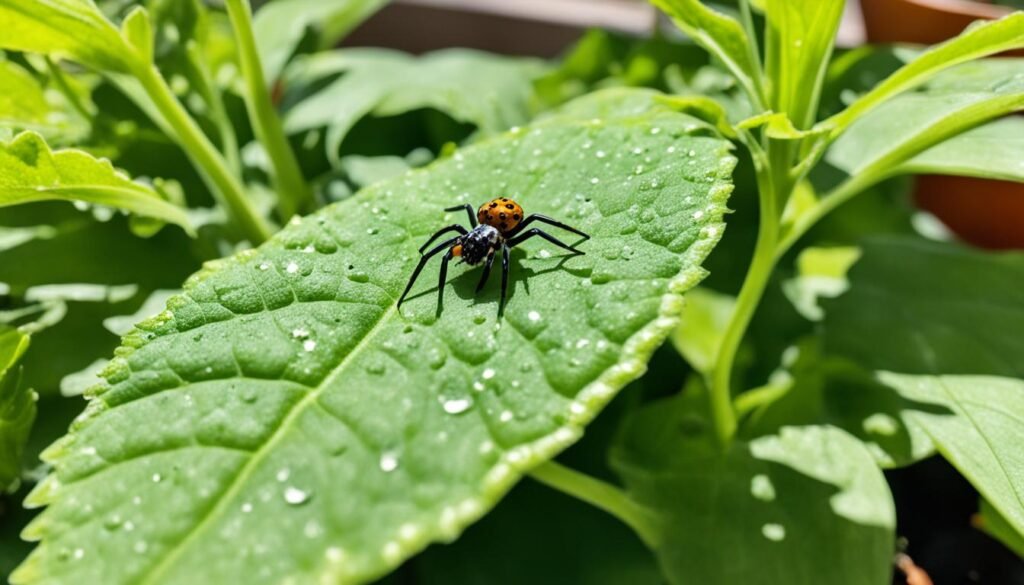
Plant-Based Insect Repellents
In the quest to create a lush, thriving garden, gardeners often face the challenge of managing unwanted pests. However, there is an eco-friendly solution that harnesses the power of nature: plant-based insect repellents. These natural alternatives offer a safe and sustainable approach to deterring garden invaders.
Essential Oils and Their Uses
At the forefront of plant-based insect repellents are essential oils. These concentrated plant extracts possess remarkable properties that can effectively repel a variety of garden pests. From the refreshing scent of peppermint to the earthy aroma of lemongrass, essential oils provide a chemical-free way to protect your plants.
- Peppermint oil: Deters aphids, spiders, and ants
- Lemongrass oil: Repels mosquitoes, fleas, and ticks
- Citronella oil: Effectively drives away mosquitoes and other flying insects
- Lavender oil: Discourages aphids, caterpillars, and moths
To harness the power of these essential oils, simply dilute them in a carrier oil or water and apply them directly to your plants or surrounding areas. The natural scents confuse and deter pests, creating a barrier against unwanted garden invaders.
| Essential Oil | Pests Repelled | Application |
|---|---|---|
| Peppermint | Aphids, Spiders, Ants | Dilute in water or carrier oil, spray on plants |
| Lemongrass | Mosquitoes, Fleas, Ticks | Dilute in water or carrier oil, apply around seating areas |
| Citronella | Mosquitoes, Flying Insects | Diffuse or burn citronella candles in outdoor spaces |
| Lavender | Aphids, Caterpillars, Moths | Dilute in water or carrier oil, spray on plants |
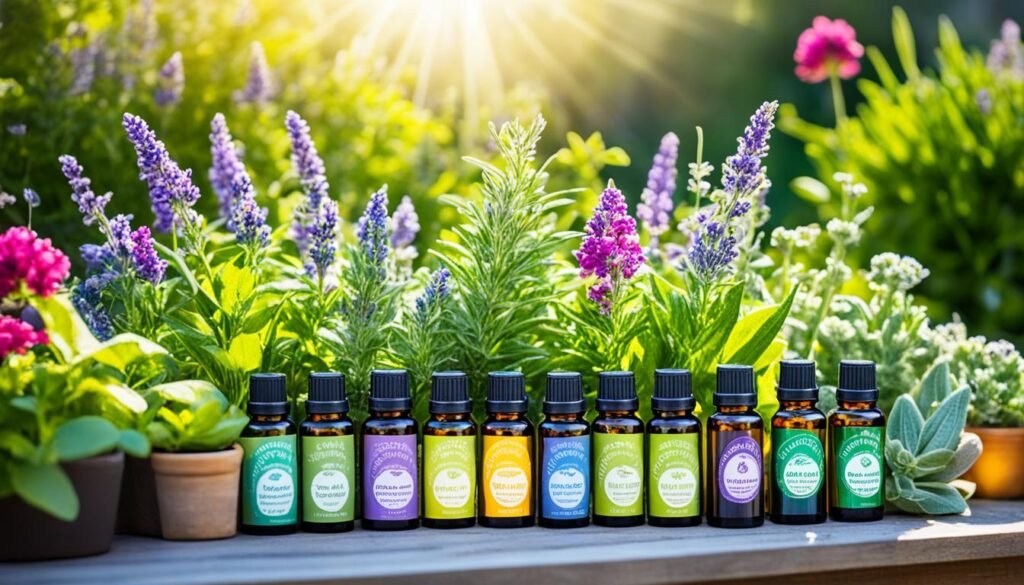
By incorporating these plant-based insect repellents into your gardening routine, you can create a harmonious and eco-friendly environment that keeps pests at bay while allowing your plants to thrive naturally.
Pest Monitoring and Early Detection
Effective pest management starts with vigilant pest monitoring and early detection. By regularly inspecting your garden, you can identify potential pest issues before they spiral out of control, aligning with the principles of Integrated Pest Management (IPM).
Regular inspection of your plants is crucial for identifying the early signs of pest activity. Look for visible signs of damage, such as chewed leaves, discoloration, or the presence of insects. Pay close attention to the undersides of leaves, where many pests tend to hide.
- Use a magnifying glass or hand lens to closely examine your plants for any signs of pest infestation.
- Gently shake or tap plants to dislodge any hidden pests that may be present.
- Monitor for the presence of eggs, larvae, or adult insects, as well as any telltale signs of their activity.
In addition to visual inspection, you can also use pest traps or pheromone lures to monitor the presence and population levels of specific pests. These tools can help you identify the type of pest and track its activity, allowing you to take timely action before the problem escalates.
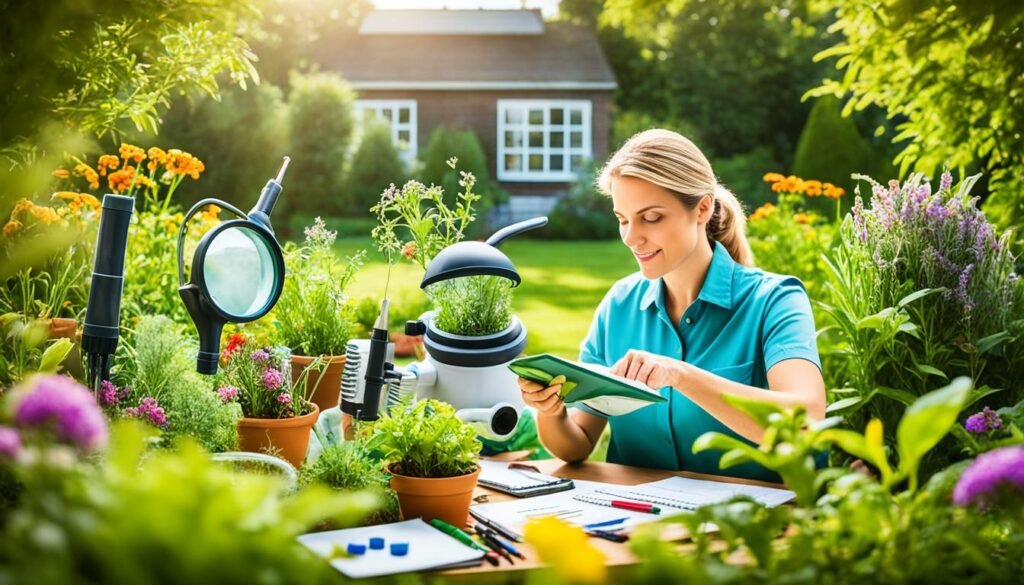
By staying vigilant and taking a proactive approach to pest monitoring and early detection, you can effectively manage garden pests and maintain the health and vitality of your plants.
Companion Planting: A Natural Pest Deterrent
In the quest for sustainable and eco-friendly gardening, one powerful technique stands out: companion planting. This age-old practice harnesses the natural synergies between plants to create a harmonious and pest-resistant garden ecosystem. By strategically pairing certain herbs and flowers, you can leverage their unique properties to deter common garden pests and reduce the need for harsh chemical pesticides.
Herb and Flower Companions
When it comes to companion planting, certain herbs and flowers have proven to be particularly effective in repelling pests. Here are some of the top Companion Planting options to consider:
- Marigolds: These vibrant flowers emit a strong scent that deters a variety of pests, including aphids, nematodes, and some types of beetles.
- Basil: Not only is basil a delicious culinary herb, but it also acts as a natural Pest Deterrent for tomatoes, asparagus, and peppers.
- Lavender: The soothing aroma of lavender can repel moths, fleas, and mosquitoes, making it a valuable addition to any Organic Pest Management strategy.
- Nasturtiums: These cheerful flowers produce a pungent odor that can confuse and deter aphids, whiteflies, and other common garden pests.
| Companion Plant | Pest(s) Deterred | Benefit |
|---|---|---|
| Marigolds | Aphids, Nematodes, Beetles | Emit a strong scent that deters a variety of pests |
| Basil | Aphids, Spider Mites | Acts as a natural Pest Deterrent for tomatoes, asparagus, and peppers |
| Lavender | Moths, Fleas, Mosquitoes | Repels pests with its soothing aroma |
| Nasturtiums | Aphids, Whiteflies | Produce a pungent odor that can confuse and deter pests |
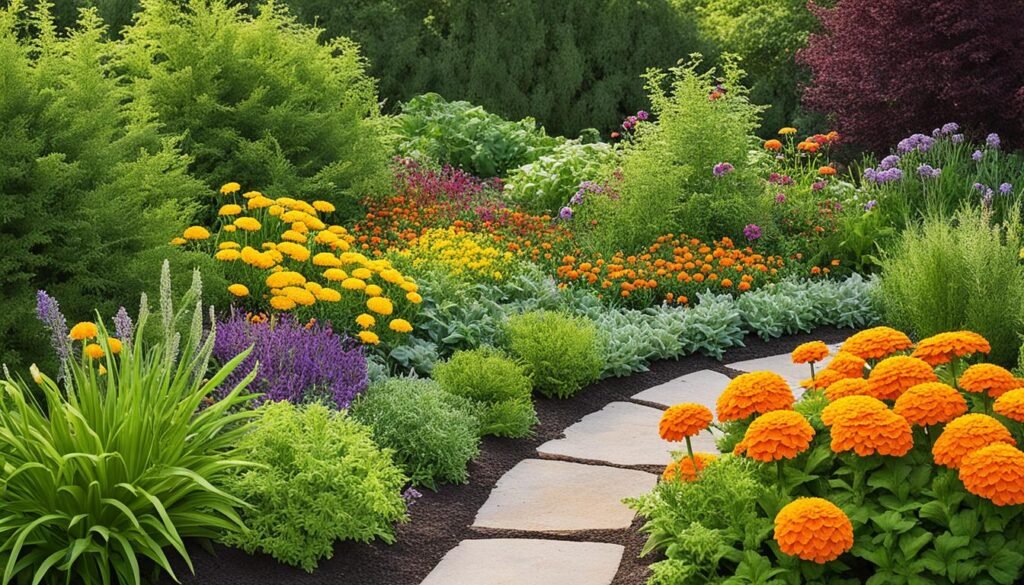
By incorporating these Companion Planting options into your garden, you can create a natural and effective Pest Deterrent, reducing the need for harsh chemical Organic Pest Management solutions. Embrace the power of plants to combat garden pests and cultivate a thriving, sustainable ecosystem.
Organic Pesticides: A Last Resort
In the pursuit of maintaining a thriving and sustainable garden, it’s essential to consider organic pesticides as a last resort. While these natural alternatives can be effective in managing garden pests, the focus should first be on preventive measures and integrated pest management (IPM) strategies.
The principles of IPM emphasize the importance of understanding the garden ecosystem and promoting a balanced environment that supports beneficial insects and natural pest control. By implementing IPM, gardeners can explore a range of non-chemical methods to address pest issues before resorting to organic pesticides.
Organic pesticides can play a role in the IPM approach, but they should be used judiciously and as a targeted solution. These natural products, derived from plant extracts or minerals, can be effective in addressing specific pest problems while minimizing the impact on the overall garden ecosystem.
Responsible Use of Organic Pesticides
- Identify the specific pest problem and the appropriate organic pesticide to address it.
- Apply the organic pesticide only when necessary, following the manufacturer’s instructions carefully.
- Avoid broad-spectrum applications and focus on spot treatments to protect beneficial insects and maintain a healthy garden balance.
- Monitor the garden closely to ensure the organic pesticide is effectively controlling the target pest without causing unintended consequences.
| Organic Pesticide | Target Pests | Application Guidelines |
|---|---|---|
| Neem Oil | Aphids, Mites, Whiteflies | Spray on affected plants, following label instructions |
| Bacillus thuringiensis (Bt) | Caterpillars, Worms | Apply to plant foliage as directed |
| Diatomaceous Earth | Crawling Insects, Slugs | Sprinkle around the base of plants |
By embracing the principles of Organic Pesticides, Integrated Pest Management, and Sustainable Gardening, gardeners can achieve a harmonious balance in their outdoor spaces, fostering a thriving ecosystem that supports both plants and beneficial insects.
Creating a Balanced Garden Ecosystem
Cultivating a balanced garden ecosystem is the key to sustainable gardening. By promoting biodiversity, you can create a thriving, self-regulating environment that naturally controls pests and supports the overall health of your garden. This approach goes beyond simply eliminating unwanted insects; it focuses on fostering a diverse community of organisms that work in harmony to maintain the delicate balance of your garden.
Promoting Biodiversity
To promote biodiversity in your garden, consider incorporating a wide variety of plants. This includes not just the vegetables, fruits, and flowers you desire, but also native plants that provide food and shelter for a range of beneficial insects, birds, and other wildlife. By creating a diverse habitat, you’ll attract a broader spectrum of organisms that can work together to maintain a balanced garden ecosystem.
- Incorporate a mix of flowering plants, trees, and shrubs to provide nectar, pollen, and shelter for pollinators and predatory insects.
- Introduce native plants that are adapted to your local climate and soil conditions, as they are more likely to thrive and support indigenous wildlife.
- Avoid using broad-spectrum pesticides, as they can harm beneficial organisms and disrupt the delicate balance of your garden.
By fostering a balanced garden ecosystem through the promotion of biodiversity, you can enjoy a vibrant, resilient, and sustainable gardening experience.
Conclusion
As we conclude our exploration of eco-friendly pest control strategies, it is clear that sustainable gardening is not only possible but also essential for maintaining a thriving and balanced garden ecosystem. By adopting the principles of Eco-Friendly Pest Control, Sustainable Gardening, and Organic Pest Management, gardeners can create a harmonious environment that supports a diverse range of beneficial insects and minimizes the need for harsh chemical interventions.
Throughout this article, we’ve delved into the intricate world of garden pests, uncovered the importance of pest identification and prevention, and discovered the remarkable power of beneficial insects as nature’s pest control agents. By combining strategies like integrated pest management, companion planting, and the use of plant-based insect repellents, gardeners can effectively manage pests while nurturing a vibrant, eco-friendly garden.
The key to success lies in adopting a holistic approach that prioritizes the balance and well-being of the entire garden ecosystem. By cultivating a diverse array of plants, promoting biodiversity, and minimizing the use of synthetic pesticides, gardeners can create a thriving oasis that not only looks beautiful but also supports a healthy, resilient, and sustainable environment. Embrace these principles, and unlock the true potential of your garden to flourish in harmony with nature.
FAQ
What are the most common garden pests and how can I identify them?
Common garden pests include aphids, spider mites, caterpillars, slugs, and various types of beetles. Proper pest identification involves closely examining the affected plants for signs of damage, such as chewed leaves, webbing, or the presence of the pests themselves.
How can I prevent pest infestations in my garden?
Preventive measures include maintaining healthy soil, encouraging biodiversity, using companion planting, and implementing integrated pest management (IPM) techniques. These strategies help create a balanced ecosystem that discourages pest populations from taking hold.
What are some beneficial insects that can help control pests naturally?
Beneficial insects like ladybugs, lacewings, and predatory mites are natural predators of many garden pests. Attracting and encouraging these beneficial insects can help establish a natural pest control system in your garden.
What are some effective organic pest management strategies?
Organic pest management strategies include using organic pesticides as a last resort, applying physical barriers, hand-picking pests, and utilizing plant-based insect repellents. These methods focus on maintaining a healthy, balanced garden ecosystem while minimizing the use of synthetic chemicals.
How can I monitor and detect pests early in my garden?
Regular garden inspections, monitoring for signs of pest activity, and using pest traps can help you identify and address infestations early on. This proactive approach is crucial for effective and sustainable pest management.
Can companion planting help deter pests in my garden?
Yes, companion planting can be an effective natural pest deterrent. Certain herbs, flowers, and vegetables can repel or confuse pests, helping to create a diverse and resilient garden ecosystem.
When should I consider using organic pesticides in my garden?
Organic pesticides should be used as a last resort, after exploring other preventive and natural control methods. They should be applied selectively and targeted to specific pest problems, while still maintaining the overall health and balance of the garden ecosystem.

